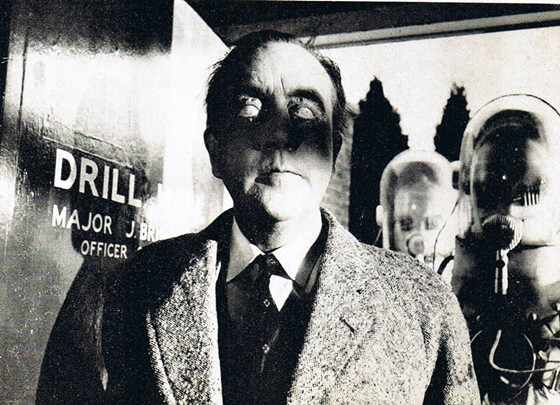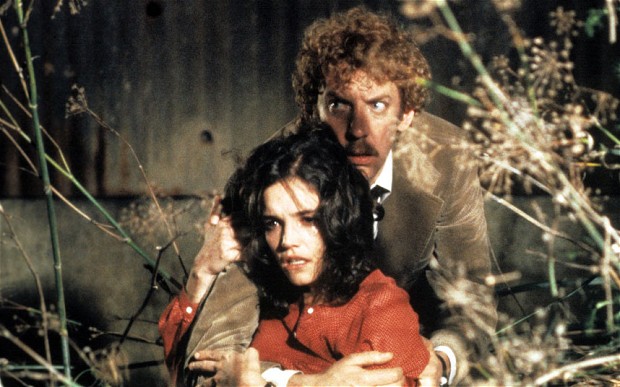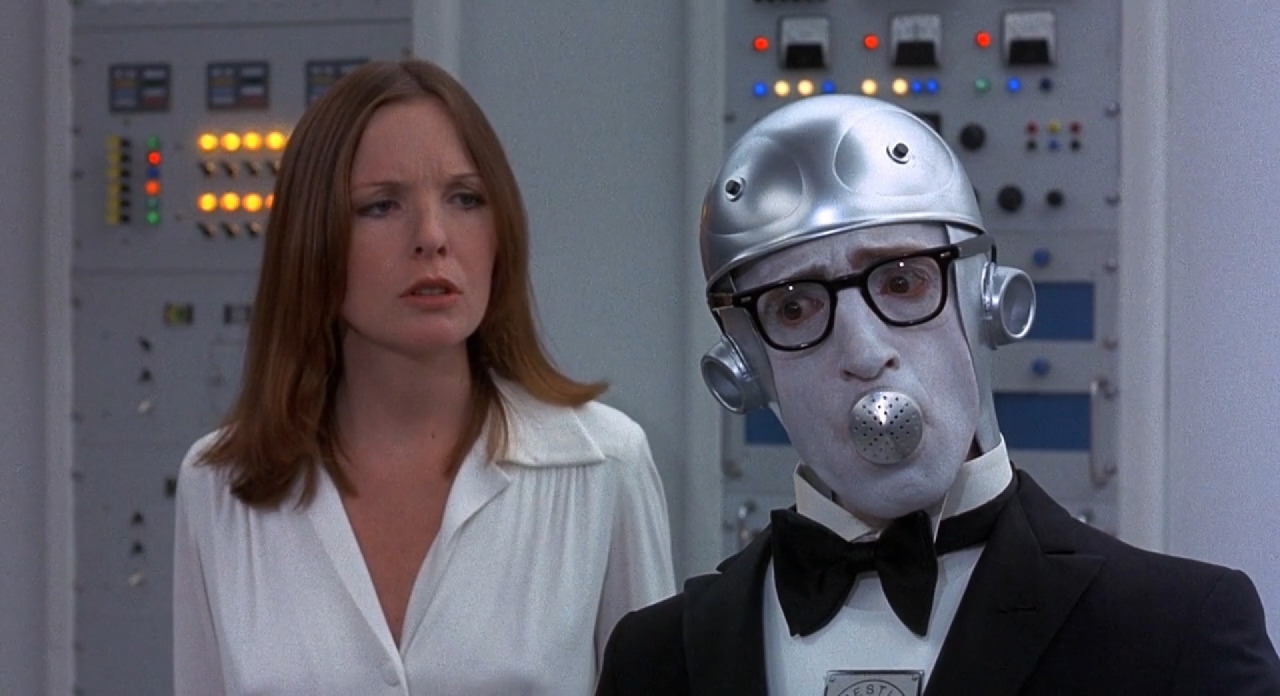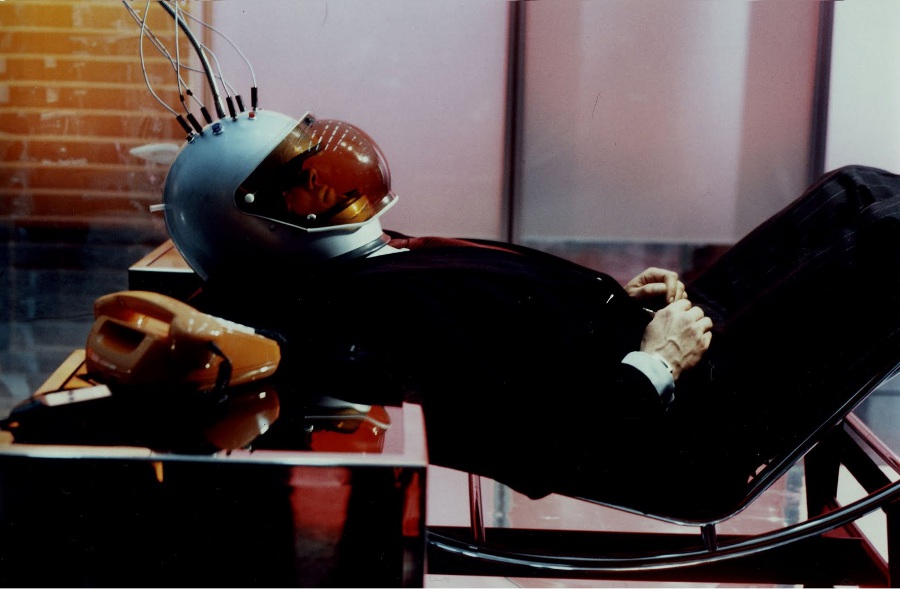6. The Earth Dies Screaming (1964)

Forget the silly title, Terence Fisher’s no-nonsense sci-fi thriller is a tight and effective exercise in suspense. In fact, although it only clocks in at just over an hour, some of the talky scenes could have been trimmed to make it an ultra-lean short, sharp shock.
As it stands, this Wyndham-esque alien invasion tale wastes no time plunging into an apocalyptic scene. A steam train barrels along a track, its engineer dead at the brakes; a plane falls from the air and goes up in flames; people start dropping like flies in the streets.
This strange event leaves a small group of stock characters to hole up in an English village pub to try figuring out what has caused the fatal attack. It doesn’t take long for the culprits to reveal themselves – a gang of potato-headed aliens in silvery spacesuits with a deadly ray-touch. To make matters worse, they are using radio waves to raise the dead as slow moving, white-eyed zombies.
Although the title suggests histrionics, The Earth Dies Screaming is notable for its use of silence to heighten the atmosphere and ramp up the tension. The opening scenes of a quaint village strewn with fallen bodies are simple and effective while the aliens’ impassive silence and blank faces are unnerving, despite the hokey costume design.
Terence Fisher was a dab hand at generating chills on limited budgets, as a journeyman director who found his calling helming horror movies for Hammer. His experience really shows here. There are a few excellent suspense scenes, one involving a wardrobe that will have you chewing your knuckles along with the protagonist.
The Earth Dies Screaming is a forgotten gem of British sci-fi cinema, one that prefigured Night of the Living Dead’s zombie outbreak by four years. It doesn’t quite reach the heights of Romero’s genre-defining masterpiece, but at its best it will have you on the edge of your seat.
7. Invasion of the Body Snatchers (1978)

Jack Finney’s 1954 novel, The Body Snatchers, has been adapted to film four times to date. His menacing tale of alien seed pods that can assimilate and produce soulless replicas of their hapless victims has tremendous metaphorical power in any decade. Philip Kaufman’s 1978 remake/sequel takes the concept from the Small Town USA of the book and 1956 original and plays out what would happen if the spores made their way to a large metropolis. The results are terrifying.
While the film has more than its fair share of shock moments, from the first sighting of a half-formed pod person to its famously bleak ending, it is the accumulation of eerie background details that are really unnerving, many of which don’t reveal their true significance before a second viewing. A school teacher can be overhead encouraging her young students to pick the strange new flowers that have bloomed overnight, and what exactly is that grey furry stuff the garbage trucks keep taking away?
There are further clues that the protagonists fail to notice, presumably due to desensitization towards their urban environment. Notice the constant sirens, groups of citizens standing around looking strangely blank and inert, and people getting chased through the streets. It all creates a sense of a city gradually becoming one giant hive mind arrayed against the few remaining humans, an organism coldly and ruthlessly bent on taking over completely.
W.D. Richter’s detailed screenplay patiently builds an atmosphere of dread and acute paranoia, while also giving us four very relatable protagonists to root for. Donald Sutherland and Brooke Adams are terrific as friends who could have been lovers under other circumstances, while Jeff Goldblum and Veronica Cartwright offer great support as a hot-headed writer and his highly strung wife. Leonard Nimmoy enjoys a break from Spock in a villain role, as a conceited celebrity psychologist who is transparently in league with the pod people – to us, at least. Also watch out for a cameo from Kevin McCarthy, briefly reprising his role and famous cry of “You’re next!” from the ‘56 original.
Kaufman’s Invasion of the Body Snatchers is the scariest and most fully realised version of Finney’s original tale. It speaks to today while also feeling very much of its era, taking cues from paranoid thrillers of the 70s like The Conversation and The Parallax View, while also tapping into elements of the body horror pioneered by its contemporaries from David Lynch and David Cronenberg. Simply one of the best remakes ever made.
8. Upstream Color (2013)

After his brain-twisting micro budget debut Primer, Shane Carruth followed up with the no less confounding but far more emotionally engaging Upstream Color. To say too much about the plot would reveal everything and almost nothing about the beguiling way it plays out. Even if you know the story or are watching again, it still requires the utmost attention to keep your bearings within Carruth’s elliptical, abstract narrative.
The basic story follows a young woman who falls under the spell of a thief, who forces her to swallow a strange larva. This makes her extremely susceptible to mind control, and he uses his power over her to rob her blind. Once the thief releases her, she has no knowledge of her ordeal, although she is deeply traumatized by it. Later, when she makes a connection with a man who has been through a similar experience does she start to realise she is not the only one, and we gradually learn the strange life cycle of the hypnotic larvae.
Although still low budget, Carruth had megabucks to play with for this peculiar story in comparison to Primer, and it shows. For a film with such limited resources it looks absolutely gorgeous, warranting some critics’ comparisons with Terence Malick. Once again it’s a true one-man-show from the director, who also wrote, produced, shot, co-edited, scored and starred in the film, although his co-star Amy Seimetz also deserves major plaudits for her captivating performance as the woman inadvertently trapped in a strange somnambulistic state.
Upstream Color is likely to confuse and annoy more people than it delights; it really is a film for viewers who enjoy working for their rewards, a film that is better experienced than understood. Although the story itself is arguably stranger than Primer, you at least won’t need to sit down with a set square and abacus afterwards and draw yourself a diagram to figure out what just happened. It also has far more heart – the last shot would sound ridiculous ahead of time, but in context of everything that goes before, it is truly touching.
9. Sleeper (1973)

Miles Monroe (Woody Allen) is the neurotic owner of a health-food store in Greenwich Village who goes into hospital for a routine operation and wakes up 200 years in the future, resulting in madcap antics and falling over a lot. Paying homage to silent era stars legends like Buster Keaton and Harold Lloyd, Sleeper is the quintessential movie from Allen’s “early, funny ones”.
Set in 2173, we can tell it’s the future because everyone wears flowing white clothing, eats blue food and rides around in bubble cars. On the run from the dystopian leader’s henchmen, kidnaps Luna Schlosser (Diane Keaton), an airheaded, pampered artist with a PhD in oral sex. Naturally, they hate each other at first, but after a series of comedic scrapes with villainous security forces they end up falling in love.
The storyline is thin, but that’s not a deal breaker. It’s basically an excuse for a series of sight gags and slapstick bits of business. Falling over features in a lot of them, to varying degrees of hilarity. One of the most inspired moments involves Monroe and an assailant trying to keep their feet while fighting on a genetically enlarged banana peel.
In terms of set and costume design, Sleeper is clearly poking fun and movies like 2001 and THX-1138, and Allen gets plenty of mileage from all the weird and wonderful sci-fi gadgets Monroe encounters. Along the way he has a fight with an out-of-control instant pudding, gets high on a silver orb that future folk pass around at a party like a spliff, and learns to love the Orgasmotron, a cubicle used for sex without all those icky bodily fluids.
Woody plays Woody, mugging for laughs and committing wholeheartedly to the pratfalls, while still finding time for some of his trademark one-liners. Keaton is arguably funnier as Luna, showing real comic chops. Their friendship dated back to the Broadway version of Play it Again, Sam, and their rapport is fantastic.
Sleeper is a breezy, throwaway comedy that largely avoids anything resembling political commentary, apart from the occasional out-of-time Nixon joke. In our current era where almost everything has become heavily politicized, such a burst of pure goofball fun comes as welcome respite.
10. World on a Wire (1973)

Klaus Löwitsch plays Fred Stiller, an overworked and irritable scientist developing the “Simulacron”, a supercomputer that perfectly replicates our world in miniature, complete with 9000 “identity units” who can live, love, work, dream, and lead ordinary existences without any idea that they aren’t real. After his superior meets with a mysterious accident before he is able to reveal an incredible discovery, Stiller investigates and starts to suspect that our own world may also be a simulation…
Originally a two-part mini series for German television, Rainer Werner Fassbinder’s World on a Wire is a chunky, slow-burning adaptation of Daniel F. Galouye’s 1964 novel. The director luxuriates in the details and world-building, devoting almost the entire first episode to creating a sense of clammy, dislocated paranoia. The chilly modernist set design and peculiar acting styles all seem deliberately chosen to alienate, creating an uneasy feeling that something is deeply wrong with this retro-futuristic society.
Fassbinder’s film anticipates many concepts and questions about simulations, virtual worlds, and the very nature of existence that wouldn’t enter mainstream conversation for another few decades. The idea of people living inside a simulated world without knowing would receive Hollywood blockbuster treatment with The Matrix, and theorists like to thrash out the possibility that our own existence may also be a simulation. It’s fascinating to see how ahead of its time World on a Wire was, although its plot twists will be familiar to anyone with at least a passing knowledge of the Wachowski’s masterpiece or similar works.
Nevertheless, for fans of sci-fi dystopias and worlds within worlds, the film is the equivalent of curling up in front of the fire with a good novel. Fassbinder directs with his usual muscular assuredness and flashes of camp – Löwitsch’s performance is very flamboyant at times, and what’s with the half-naked hunky black chef? While it may not hold many surprises for a modern audience, half the fun of World on a Wire is just getting lost in the maverick director’s outlandish vision.